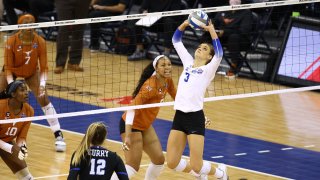
Volleyball players can expect massive changes to game play this season as the NCAA Playing Rules Oversight Panel approved several new rules in the game.
Some of the new rules include allowing double contacts, two liberos in each game, new types of jewelry and more.
While some of these rules are beneficial, many players are upset over one change in particular.
Here’s an in-depth look at the new rules, why they’re important and what they mean.
Get New England news, weather forecasts and entertainment stories to your inbox. Sign up for NECN newsletters.
Double contact approved
Players are now allowed to double-touch the ball on the second contact of the play.
Here’s how the typical play process works:
- First, a defensive specialist --- the people in the back row of the court --- passes a ball to the setter --- in the front right position of the court.
- Then the setter sets the ball with two hands towards the hitter --- another player in the front row. This serves as the second contact in the play.
- Finally, the hitter swings their arm while jumping in the air to hit the ball over the net to their opponents.
While there are much more in-depth plays, those three steps are the basics of how the three main contacts of volleyball work.
Sports
Patriots, Red Sox, Bruins, Celtics and more
The double contact rule now allows for the setter, or whoever needs to touch the ball on the second contact, to quickly touch the ball twice.
However, according to the NCAA, “if the ball is played over the net in this type of scenario, it would be ruled a fault, and the team would lose the point.”
In the past, a double contact is called on the setter when their hands are not perfectly even when setting the ball. Due to this call, the team would lose a point because the setter or player’s hands were not in the perfect setting position.
Referees can usually tell this because when the ball is perfectly set, there is little to no spin on the volleyball after the setter touches the ball. When a double contact happens, the ball is typically spinning.
But now, setters and those who touch the ball on the second contact, will not lose the point for their team because of a double contact.
So why are players mad about this?
For players who have not been playing for a long time, the rule could be helpful. But for veterans and long-term players who have spent years perfecting their set, the rule may seem frustrating.
The NCAA said they determined double contacts are allowed because over the years there has been intense debates between coaches and volleyball officials during games.
The NCAA claimed the rule change will spark less debate and will also help continue plays so games are more entertaining for fans and players.
Two liberos can play in the same set
The NCAA also approved two liberos to be able to play on the court during the same set but they cannot be on the court at the same time.
What is a libero?
A libero is a defensive specialist who wears a different color jersey. They can be found in the back row with the other defensive specialists.
They wear a different colored jersey because they are allowed to substitute in for another player, usually hitters, without using a legal substitute. Teams are only permitted 13 substitutes per set, so this allows hitters and liberos to change out even when all of the permitted substitutions have been used.
So how does this impact the game?
Hitters and liberos can now use fewer substitutions during a game, which allows for teams to use more players throughout a game or to be able to change the players that are in more frequently in case a game is very back-and-forth.
The NCAA said, “The rationale for the proposal is to allow more players the opportunity to compete and to increase action and improve play.”
Other rules changes
To see more rule changes and experimental rules for the season, take a look at the NCAA’s website.



